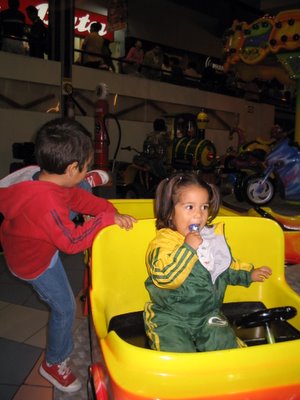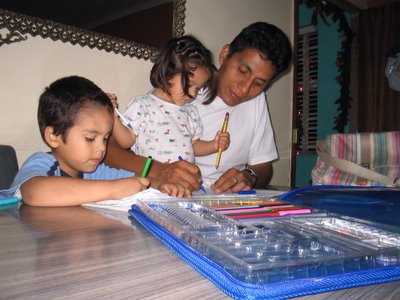Practiquemos para el examen # 3
The exam covers Chapters 5 and 6. It is three pages long.
Instructions:
I. Comprensión Auditiva.: You will read six statements, then listen to a passage in Spanish which will be read twice. Then you’ll indicate whether the statements are cierto o falso: (6 x 2 = 12)
II. Preguntas Orales: You will hear five questions. They will be read twice. You will answer each one with a full sentence in Spanish. You can’t take any notes. (5 x 3 = 15)
III. Vocabulario: You will identify what’s happening in 2 drawings, using words from the new vocabulary. (10 x 1 = 10)
IV. Situaciones: You will write in Spanish responses in a dialogue described in English, from the point of view of the one of the people in the dialogue. (5 x 3 = 15) V. Gramática: There are 4 sections that concentrate on different grammar topics: You have to write 4 commands; you have to answer questions using direct object pronouns; you have to make 3 comparisons; and in the last section there are a variety of grammar points and you must choose one of several words in parenthesis to complete a paragraph. (36 points)
VI. Lectura: You will read a passage then answer 4 comprehension questions. Some are multiple choice, some are cierto-falso. (4 x 3 = 12)
Vamos a practicar!!!
SPAN 1115 EXAMEN 3 (Práctica) Primavera 2005
I. Comprensión Auditiva.: You will read six statements, then listen to a passage in Spanish which will be read twice. Then you’ll indicate whether the statements are cierto o falso: (6 x 2 = 12) (Go to Supplementary Materials page 70)
Ask a classmate to read this text to you, and listen to her/him:
Buenos días, radioyentes de Dallas. Ahora el boletín de las ocho. Otro día soleado aquí en Dallas, con temperaturas máximas alcanzando los ochenta y cinco (85) grados y las mínimas tal vez bajando hasta los cincuenta (50) grados esta noche. Para mañana, se espera otro día muy agradable, despejado, con vientos leves del norte.
Buenos días, Philadelphia. El servicio nacional climatológico les trae las últimas noticias sobre la primera tempestad del invierno. Está nevando fuertemente ahora, con acumulaciones en algunas partes de Philadelphia de hasta 14 pulgadas, con temperaturas máximas solo alcanzando los treinta y cinco (35) grados. Esta noche, se espera temperaturas bajando hasta los quince (15) grados. Por suerte, mañana va a dejar de nevar. Va a hacer sol, pero continuará el frío intenso.
Buenos días, Miami. Les traigo el boletín del mediodía. No salgan hoy sin impermeable, porque se esperan lluvias torrenciales para hoy, continuando por la tarde. El frente tropical llegó, y ya está lloviendo a cántaros en algunas partes de Miami. Debido a las lluvias, la temperatura ha bajado desde un alto de noventa y dos (92) grados hasta la temperatura mínima actual de setenta y cuatro (74) grados. Para mañana se espera otra vez lluvia y muchísima humedad.
Buenas tardes, Los Angeles. El servicio nacional climatológico advierte que, otra vez, los niveles de smog han alcanzado niveles peligrosos. Hoy se espera que el tiempo va ha seguir igual que ayer, nublado, con temperaturas máximas llegando tal vez a los sesenta y cinco (65) grados y las mínimas bajando hasta los cincuenta (50) grados. Para mañana, se espera un día de sol con una leve subida de temperatura.
Buenas tardes, Chicago. Aquí en la ciudad ventosa se espera un día típica de invierno, con un viento fuertísimo del lago Michigan y un frío intensísimo. Se espera que la temperatura máxima alcanzara los veintiséis (26) grados, con temperaturas mínimas bajando a los doce (12) grados esta noche. Mañana va a estar nublado, con posibilidades de nieve en la tarde y en la noche.
Answer in your S.M. (p.70) El boletín metereológico
II. Preguntas Orales: You will hear five questions. They will be read twice. You will answer each one with a full sentence in Spanish. You can’t take any notes. (5 x 3 = 15)
Ask a classmate to read this questions to you, and answer each question as soon as she/he finishes each of them:
¿Cuál es tu estación favorita?
¿Qué haces cuando estás nervioso?
¿Cuál es el plato que se come después del plato principal?
¿Qué platos sabes preparar?
¿Qué restaurante recomiendas para una cita romántica?
III. Vocabulario: You will identify what’s happening in 2 drawings, using words from the new vocabulary. (10 x 1 = 10)
IV. Situaciones: You will write in Spanish responses in a dialogue described in English, from the point of view of the one of the people in the dialogue. (5 x 3 = 15)
1. Prof. Ghersi asks a student from the class for his homework, and he explains that he just got the e-mail she had sent two days ago with the assignment.
………………………………………………………………………………………………..
2. A student from the class is going to have a party at his apartment for the end of the semester. What kind of advise you give to him?, using a command.
………………………………………………………………………………………………...
3. One of your classmates is going to Cusco (Peru) to do hiking during Summer vacations. She asks you if you know the country, how do you answer at her questions?
………………………………………………………………………………………………...
4. The same classmate asks you if you know anything about Cusco. How do you answer?
………………………………………………………………………………………………
5. You know South America has more places than The United States to do outdoor activities, how do you say that in Spanish using comparisons?
...................................................................................................................................................
V. Gramática: There are 4 sections that concentrate on different grammar topics: You have to write 4 commands; you have to answer questions using direct object pronouns; you have to make 3 comparisons; and in the last section there are a variety of grammar points and you must choose one of several words in parenthesis to complete a paragraph. (36 points)
Sección 1: Your friend is coming to Gainesville to visit you, write 4 commands saying what kind of weather we have these coming days and what kind of clothing she/he needs to bring to Gainesville.
Sección 2: You are buying cloths (unos pantalones, unas sandalias, una camisa y un cinturón). How do you say:
I want (querer) them in a bag………………………………………………………..
I am going to put (usar/llevar) them (los pantalones) on right now…………………
I want (querer) it (la camisa) in white with pink flowers……………………….……
He is going to put (llevar) it (el cinturón) on…………………………………………
I am not going to buy (comprar) them (las sandalias)……………………………….
Sección 3: Make tres (3) comparisons:
¿Qué te gusta más: el hígado o el pescado?..................................................................
¿Quién es más bonita: tu novia o tu hermana?.............................................................
¿Qué clase te gusta más: la de español o la de inglés?..................................................
Sección 4: Grammar points to be checkeb in class: Supplementary Materials pages 88, 89, 90, 91, 92 and 93.
VI. Lectura: You will read a passage then answer 4 comprehension questions. Some are multiple choice, some are cierto-falso. (4 x 3 = 12)
Lecture will be one of the texts from Puntos de Partida, chapter 6 (p.220)


